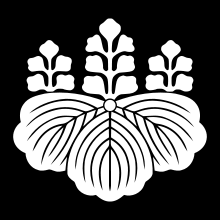Toyotomi clan
| Toyotomi clan 豊臣氏 | |
|---|---|
 The emblem (mon) of the Toyotomi clan | |
| Home province | Various |
| Titles |
Kampaku Daijō-daijin |
| Founder | Toyotomi Hideyoshi |
| Final ruler | Toyotomi Hideyori |
| Founding year | 1584 |
| Dissolution | 1615 |
| Ruled until | 1615, Siege of Osaka |
The Toyotomi clan (豊臣氏 Toyotomi-shi) was a Japanese clan that ruled over Japan before the Edo period.
Unity and conflict
The most influential figure within the Toyotomi was Toyotomi Hideyoshi, one of the three "unifiers of Japan". Oda Nobunaga was another primary unifier and the ruler of the Oda clan at the time. Hideyoshi joined Nobunaga at a young age, but was not highly regarded because of his peasant background. Nevertheless, Hideyoshi's increasing influence allowed him to seize a significant degree of power from the Oda clan following Oda Nobunaga's death in 1582. As the virtual ruler of most of Japan, Hideyoshi created a new clan name "Toyotomi" in 1584, and achieved the unification of Japan in 1589.
When Hideyoshi died in 1598, his son Toyotomi Hideyori was only five years old. Five regents were appointed to rule until his maturity, and conflicts among them began quickly. In 1600, Tokugawa Ieyasu deposed Hideyori and took power after winning the Battle of Sekigahara. In 1614, Hideyori came into conflict with the Tokugawa clan, leading to Tokugawa Ieyasu's Siege of Osaka from 1614 to 1615. As a result of the siege, Hideyori was forced to commit seppuku. After his death, the Toyotomi clan dissolved, leaving the Tokugawa clan to solidify their rule of Japan and the last member of the Toyotomi clan was Tenshuni (1609-1645). A rumour said that Toyotomi Hideyori's son Toyotomi Kunimatsu escaped execution, and another rumour said that Hideyori had an illegitimate son named Amakusa Shiro.
Other notables